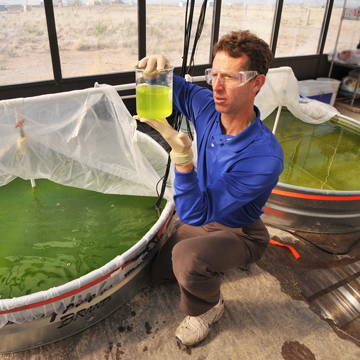A third act for California’s Bldg. 968

Studies show that the average working American will have at least three and as many as seven careers in his or her lifetime. This means that Bldg. 968, now in its third career after 35 years of existence, is right on track. On Nov. 22, Div. 8000 VP Rick Stulen and Center 8600 Director Glenn Kubiak led an official rededication ceremony for Bldg. 968. Known as the Chemical and Radiation Detection Laboratory (CRDL) for the past 14 years, the building is now called the Applied Biosciences Laboratory. Rick recalled the groundbreaking for the first iteration of Bldg. 968, the Tritium Research Laboratory, in 1973 and the building’s grand opening in 1975. “It was a pretty spectacular first decade as we utilized the capability of this building to do unique research in hydrogen that considerably advanced Sandia’s reputation,” he said. In the mid-90s, Rick said, it was time for a career change for the building. “Mim John realized there was an opportunity for research into radiation and chemical detection in this building,” he added. “Following the rededication to CRDL, we had another decade or so of very vibrant research into chemical detection, most notably with MicroChemLab.” Turning to the present, Glenn posed the question of why rename a 35-year-old building. “Because it’s absolutely appropriate and acknowledges a transition that in many ways has already happened,” he said. “That transition is the growth of the importance of biology to Sandia’s missions.” He noted that in 2004, activities falling under the realm of biology and biological sciences were about $23 million in scope. In the last fiscal year, that number had grown to $38 million. “I think the name, Applied Biosciences Laboratory, captures the DNA of how Sandia does its work,” he added. “Sandia is committed to deep science, and that science is always connected to a national security problem or application. There are building names all over this campus and in New Mexico, like the Distributed Information Systems Laboratory or the Center for Integrated Nanotechnology, but none are dedicated to the pursuit of biology. “This name change communicates internally to Sandia and externally to the scientific and national security communities that Sandia has been doing biology, is now doing biology, and will definitely continue to do biology. The train is solidly down the track and we will continue to grow biology.” He acknowledged the contributions of Len Napolitano (8900); former Div. 8000 VP Mim John; Duane Lindner (8120); Malin Young (8620); Grant Heffelfinger (1610); Terry Michalske (former director of Energy and Security Systems, now director of Savannah River National Laboratory); John Vitko (former director of Exploratory Systems and a former director of Biological and Chemical Countermeasures for the Department of Homeland Security); and Div. 6000 VP Jill Hruby. “It was really the individual insights, vision, and per[1]severance of those folks and many others that brought us where we are today,” Glenn said. “I want everyone to walk away today with the idea that every single individual in this laboratory has the ability, through their vision and dedication, to change what this laboratory does for the nation. Each and every one of you has that power. Please bring that power together as a team so you can help write the next chapters of biology at Sandia.”